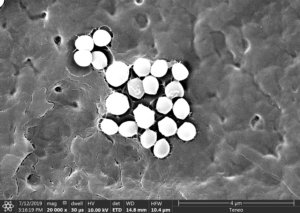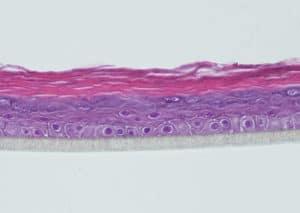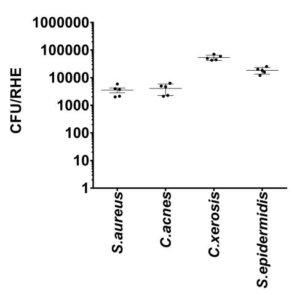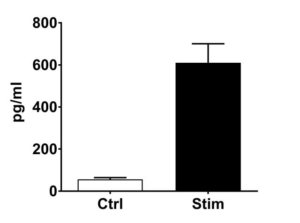The Relationship Between Microbiology Testing and the Skin Microbiota
Over the past decade, research has made it clear that having a balanced and diverse skin microbiota is essential for skin health and appearance. Many products available on the market have microbiome-friendly claims, or aim to address imbalances in the skin microbiome. Cosmetic microbiology testing is instrumental in substantiating such claims.
In this article, we will examine the role of the human skin microbiota, and various tests used by contract research organizations to substantiate microbiota-friendly, anti-microbial and other microbiome related product claims.
What is the Skin Microbiota?
The skin is the largest organ of the human body, accounting for around 15% of the total adult body weight. It is composed of 3 distinct layers: the epidermis, the dermis, and subcutaneous tissues. Together, these layers carry out several vital functions that include thermoregulation, prevention of excess water loss, and protection against external threats.
In addition, recent published data shows that the surface of the skin may also provide an optimal environment for the growth of microorganisms. Collectively, they comprise the skin microbiotame, which is intricately linked to human health and disease.
What Types of Skin Microbiota Are There?
The skin microbiota is generally divided into two groups: resident and transient microorganisms.
-
Resident microbes, also known as commensal microbes, are part of a precise group of microorganisms routinely located on the skin surface. They are often considered harmless, and even offer beneficial effects to the host. Commensal microorganisms often protect the human host against invading pathogens, either through direct antimicrobial activity, or by triggering protective immune responses in the skin.
-
Transient microbes, on the other hand, are generally harmful and pathogenic. They usually colonize the skin after injury or trauma, and may lead to infections and inflammation.
Under normal homeostatic conditions with proper hygiene, intact skin barrier function and normal resident flora, the skin microbiota is healthy. On the other hand, any imbalance in the microbiota may lead to skin diseases.
Why Do We Need a Balanced and Diverse Skin Microbiome?
The skin surface hosts a diverse population of microbes, and different anatomical areas are home to different bacterial communities. Depending on the temperature, moisture and lipid content of the skin, three main skin environments can be defined:
-
Dry areas: arms, palms, hands;
-
Moist areas: armpits, between the fingers, behind the knees (popliteal fossa), the groin (inguinal folds), navel, etc.;
-
Sebaceous areas: face, cheeks, external auditory canal, back of the scalp, upper chest and back.
While microorganisms were initially considered harmful to the skin, research today suggests that a proper balance of the skin microbiome is required to maintain skin health. Different products and methods are constantly introduced to the market to assist with maintaining a balanced skin microbiome. Consequently, research labs have developed a number of microbiome related tests to guide product research and confirm product claims.
Microbiome-Friendly Tests for Cosmetics, Skincare, and Household Care Products
Tests to check whether a substance is “microbiome-friendly” allow to substantiate manufacturer claims that a compound or formulation does not create an imbalance in the bacterial composition of the skin microbiome. When putting their products on the market, brands want to make sure that their formulas will have the potential expected effect, while not causing a disruption or dysbiosis.
Tests offered to substantiate microbiome-friendly claims include assays that measure the effect of tested compounds on bacterial growth. Such effect can be stimulating (promoting bacterial growth), bacteriostatic (stopping bacteria from reproducing) or bactericidal (killing bacteria). The viability assay shows the number of viable cells after exposure to the compound over a period of time.
Such assays can be carried out on single bacterial strains or on a bacterial mix. For example, a mix of Staphylococcus aureus, Staphylococcus epidermidis, Cutibacterium acnes and Corynebacterium xerosis is considered representative of the skin microbiome. The bacterial mix can be amended to suit specific product research needs. If the experiment also calls for quantifying specific bacterial strains in the mix, conventional microbiological tests can be used to provide that additional information.
In addition to these conventional methods, there are modern microbiome assays using 3D skin models, such as Reconstructed Human Epidermis (RHE). Research labs with expertise in tissue engineering can offer to produce customize RHE in-house for product efficacy and “microbiote-friendly” testing.
Microbiome tests using reconstructed human epidermis can measure the effect of tested products on bacterial adhesion to the skin model. As with other assays, these tests can be performed with single bacterial strains or bacterial mixes. In addition to the quantitative analysis of bacterial adhesion, electronic microscopy can also be used to provide qualitative data.
Tests to Substantiate Anti-Microbial Claims of Personal Care, Healthcare and Treatment Products
As we described earlier, the skin, while being an intricate home for many microorganisms, also has a major role in detecting invading pathogens. Indeed, under certain conditions that lead to dysbiosis or a downregulation in the immune response, microorganisms are able to circumvent normal host defense mechanism and become pathogenic. In that case, certain components of the skin (keratinocytes, fibroblasts and sebocytes) act as responders against pathogenic microorganisms and trigger cutaneous innate immune response.
Such immune response can present as acne or atopic dermatitis. Products used to treat these conditions may have anti-microbial and anti-inflammatory claims. To substantiate them, researchers design assays to evaluate the potential anti-inflammatory effect of some compounds in keratinocytes, fibroblasts or sebocytes infected by certain bacteria (e.g. Staphylococcus aureus, Staphylococcus epidermidis, Cutibacterium acnes and Pseudomonas Aeroginosa).
Moreover, using RT-qPCR technology (quantitative reverse transcription polymerase chain reaction), the effects of the tested compounds may also be analyzed using a dedicated PCR array, whereby genes have been selected for their importance in anti-bacterial activity and inflammation. Such assays can be designed for 2D and 3D models.
In this same context, contract research organizations are looking deeper into certain commensal yeasts of the skin microbiome. These include the Malassezia species, lipid-dependent microorganisms that can contribute to seborrheic dermatitis, dandruff formation, rosacea, odor and other conditions. Understanding the lipid requirements of the Malassezia species in these pathogenic states may provide insights into their biology and enable customers to test compounds with potential anti-Malasezia fungi effect.

Staphylococus aureus on RHE surface_SEMX20000
Staphylococus aureus on RHE surface_SEMX20000

Reconstructed human epidermis (HE staining)
Reconstructed Human Epidermis (HE staining)

EPIBACT-0019_Adhesion of a bacterial mix#Stim
Adhesion of a bacterial mix on RHE – Bacterial counting using qPCR (DNA identification)

NHEKBACT-0003_IL-8 release#Stim
IL-8 release on NHEK (after S.aureus stimulation) – ELISA

BACT-0001_Bacterial enumeration
Bacterial enumeration of S.aureus – Bacterial counting (CFU)
Skin Microbiome and Exposome: Analyzing How Environmental Factors Affect the Skin Microbiome
The term “exposome”, coined by prominent cancer researcher Christopher Wild in 2005, describes the sum of all environmental exposures to which an individual is subjected from conception to death. These environmental factors include solar irradiation (UV irradiation, visible and IR light), temperature, air pollution, tobacco smoke, and many more.
Given the fact that the skin is one of the major interfaces between the body and the external environment, it makes sense to pay major attention to the exposome of the human skin. As a barrier organ, the skin is subjected to a large variety of environmental factors. The microbiota housed on the human skin surface is likewise exposed. It is therefore very important to research the protective effects of compounds against skin exposome, to protect both the skin and its microbiome.
Bacterial viability assays and bacterial growth curve analysis can be used to test the protective effects of compounds against UV light in a UV light irradiated bacterial strain. There are further tests to assess how effective certain compounds are at protecting the skin microbiota against other environmental factors that are part of the skin exposome.
Microbial Enumeration of Skin Microbiome in Clinical Samples
When an experiment requires detecting and quantifying microbial strains that are part of the skin microbiota, gene expression analysis can be used to enumerate them, using specific probes for each strain. These can include bacteria and fungi, such as Cutibacterium acnes, Staphylococcus epidermidis, Staphylococcus aureus, Malassezia restricta, Malassezia furfur, and others.
The Human Microbiome: Beyond Skin
In addition to the skin microbiome, which, strictly speaking, exists on the outside of the body, other human microbiomes have key roles in our everyday life and health, and each has its distinct community of microbes .
Gut Microbiome
Modern research shows that an imbalance in the gut microbial community may lead to diseases, while restoring that balance may be used to treat them. The ecosystem of microorganisms present in the intestinal tract has important functions, such as modulating a normal immunological response, producing nutrients for the host, and preventing infections caused by intestinal pathogens. Therefore, this ecosystem should be maintained in a favorable balance. To that end, probiotics and prebiotics have been introduced into the human diet.
Prebiotics are non-viable food components that confer a health benefit on the host associated with the modulation of the microbiota.
Probiotics are live organisms which, when administered in adequate amounts, confer a health benefit to the host.
Microbiological assays can be used to assess the potential beneficial effects of a compound (pre- or probiotic) on the gut microbial community.
In addition, customized tissue plate forms may be used to create in vitro gut epithelium models, allowing to readily study the gut microbiome. The protective effect of compounds may be evaluated in this 3D model subjected to the chemical exposome present in the gastrointestinal niche.
Oral Microbiome
After the skin and gut, the oral cavity also has one of the most diverse and numerous microbiota. As a matter of fact, the oral microbiome is crucial to human health, since any imbalance in it may lead to oral and systemic diseases. A state of equilibrium in this ecosystem should be maintained, and consequently, oral care is to date one of the main concerns in the personal care research field.
Several assays are available to study and highlight the protective effects of products in keeping the oral microbiome homeostasis. 2D or 3D models derived from the oral and gingival cavity can be created using proprietary tissue engineering platforms. Using these models, proliferation, adhesion or inflammatory assays may be carried out.
Find a Cosmetic Microbiology Program to Suit Your Needs
At Bioalternatives, we are committed to developing effective in vitro alternative options to animal experimentation methods, by offering a full range of solutions for the development of active ingredients and cosmetic formulations.
We offer customized technical solutions to guide your product research and support the claims of your cosmetic products. Bioalternatives can readily provide a vast range of microorganisms and propose innovative solutions toward several claims in the skin microbiome, including microbiome-friendly, anti-microbial, protection from exposome factors, and more. Our selection of in vitro testing solutions, microbiology assays and clinical sampling can be used to characterize your cosmetic products’ active ingredients, demonstrate the efficacy of your formulations, and test the safety of your cosmetic products at an early stage (for R&D purposes only).
With extensive experience in cosmetic product testing and state-of-the-art facilities, we are pleased to offer you dedicated project management support and consulting for your R&D process.
Ready to discuss a testing and research program that will suit the needs of your business?



